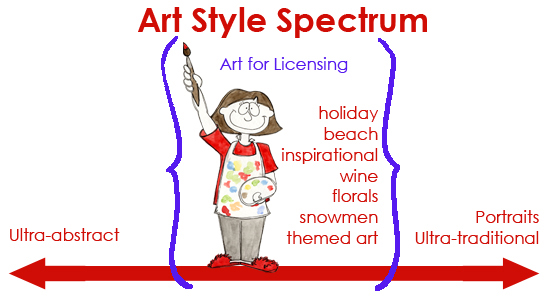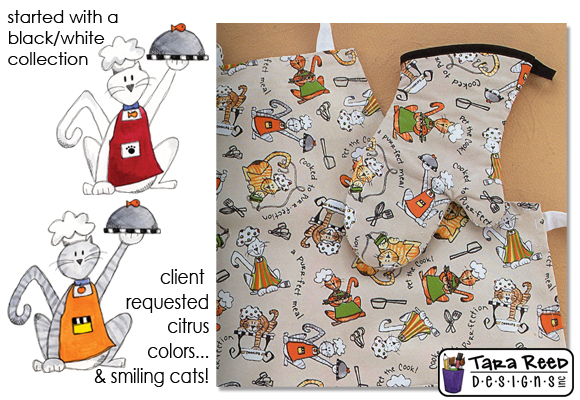By Tara Reed
So you’ve heard about art licensing and think it sounds amazing! You can create art and have several people pay you for the rights to use it. You don’t have to do any of the marketing, selling or credit card processing. Heck, you’ve heard about people who make millions doing it so why shouldn’t you?
Well… it’s not that easy.
I will begin by telling you it is possible to earn a living licensing your art and that it can be done. I built my business from the ground up and absolutely love the whole process.
I will also tell you that it isn’t for everyone. One of my missions in writing, teaching and speaking about art licensing is to give artists a realistic view of what this business is and not a pie-in-the-sky “anyone can do it!” perspective.
Reality Check
1. It takes time to start making money . . . and by time I mean it can take 1-3 years so you need an alternate source of income while you see if your art is a fit.
2. Speaking of art being a fit, not all art is suited to licensing. Art for licensing is art that will work on and help sell products. That is the whole point. Manufacturers looks for designs to use on their products so consumers will buy them. There isn’t a lot of abstract art being licensed, for example. But you will never see snowmen or roosters leave the stores because people always seem to want to buy things with snowmen and roosters. (Not necessarily together, of course.)

3. There is a lot of competition. In recent years more artists have become aware of the idea of licensing and there are more people talking about how to do it. A lot of artists who used to work for manufacturers have been downsized and have entered the pool of artists licensing their work. This means your art has to be that much better. Manufacturers have a lot of choices so you need to put your best art forward to land that deal.
4. You might be asked to create quickly. There are many times when deadlines will be tight so if you don’t like creating on the turn of a dime, you might not love the process of licensing your art. Or, if you choose not to do things quickly (which is your choice since you are in business for yourself) you simply won’t get the deal.
5. You need to be determined and you must be able to handle rejection . . . or crickets. (Meaning no response at all.) Art licensing is not for the faint of heart. It takes a lot of work to create your art and market your art. It takes a firm sense of self and the ability to listen to and learn from feedback when your art isn’t selected. You also need to be able to keep creating and marketing when you submit art and never hear anything back.
6. Changes to the art is more of a rule than an exception. In point #2 I mentioned that the whole purpose of the art in licensing is to help sell products. That could mean that a manufacturer who is interested in your work might ask for changes based on trends they are seeing in the marketplace or requests they are receiving from retailers. 
I would guess that about 80% of the work that I do is changed in some way between when I show it to a manufacturer and when it lands on a store shelf. It might be a color change, size change, or layout change. You have to know that you and the manufacturer are partners, trying to create the best product possible in hopes of lots and lots of sales. That is, after all, how you earn your living. (Most art licensing deals are done as a royalty based on sales so the more products that sell, the higher your royalty check!)
I’m feeling like the first 6 points could be construed as a bit negative but they are simply some realities of this business. It is better to know about them before you devote a lot of time and energy to creating art for licensing, right? If you know you hate to work on a deadline you can save some time and look at other money making options for your art.
The Good Stuff
Let’s finish up with some things that I absolutely love about licensing! (You will find that some of these points were mentioned before as well.)
7. When licensing your art is really working, you will be paid for the same art by multiple manufacturers. This is a concept I love. I love that I can create a holiday collection and license the rights to use the same art to different manufacturers for different projects. It makes sense to me. Why sell the art outright to a company who will only use it for paper plates and napkins? Instead I can license it to a company who makes paper plates and napkins, then to another who makes ceramic plates, and another who makes rubber stamps, etc. It is like a game to come up with art that will work across a variety of products and then connect with the people who choose the art.
8. You get to collaborate with manufacturers. This is one of my favorite things. Like many artists, I work alone in my studio, which is in my home. Not a lot of water cooler talk or heading to lunch with the gang. My co-workers become the licensing managers and art directors across the country who I talk to and brainstorm about art and product design. Very often I have art that they like and then we come up with some changes or additions to make it really fit for them. It’s so exciting to later see it in the stores and remember the conversations when the ideas were born.
9. You don’t have to focus on one product and manage all aspects – from production to marketing to sales to shipping and returns. Starting a greeting card business is a full time job. You have to study the market, create the art, invest in production and then figure out how to get the word out about your great creations. You don’t have time to also manufacture ceramic dishes, handbags and picture frames too! With licensing, you focus on the art and find the people who are making and selling and shipping – leaving you time to get back to creating the art.
10. It is so incredibly cool to go into a store and see products for sale with your art on them! After 8 years licensing my art I am still delighted each and every time it happens and hope I never become immune to the feeling. I’ve heard artists say it’s selling out to have your art mass produced but I wholeheartedly disagree. I think it is a very fun, interesting and satisfying way to make a living.

There you have some pluses and minuses of pursuing a career in art licensing. There are those who will read this and think to themselves, “This is simply not for me.” If you are one of them, I wish you much success in whatever you decide is a fit. Others will be intrigued and want to learn more. If you fall into that category, I invite you to visit my website and blog to learn more.
About the Guest Blogger
Tara Reed is a successful licensor of her art and teaches artists how to follow her path at ArtLicensingInfo.com (my affiliate link). You can visit that link, sign up for her bi-weekly newsletter, and receive her Beginner Basics audio program for just $10. Her creative juices flow in her Portland, Oregon studio.



21 thoughts on “10 Things to Know Before You Throw Your Hat in the Art Licensing Arena”
I admit I know nothing about the topic or art liscensing, so thanks for the information it really was helpful!
Excellent, honest article, Tara.
You are an inspiration!
Great article, but it seemed to be more focused on licensing for manufactured products.. Artists should be aware that there are companies out there who will license their work for use in the advertising and publishing industries ( print ads, book & magazine covers, etc ), as well as publishers who specialize in creating open & limited edition prints for both the retail and trade market. Another avenue for artists to explore..
Lesley – you are correct – I work in the art licensing industry focused on licensing art for products. Do you have any resources for artists wanting to understand how licensing works in advertising & publishing? I’d love to learn more about that aspect myself!
Thank you for the excellent article, Tara and Alyson — though I’m curious why abstract art isn’t being licensed much? Is this a general feeling in the licensing industry or is it that abstract art is more geared towards textiles and wall art instead? I’d love to know your thoughts on this.
Part of the answer to your question JJ Jacobs lies in the definition of “abstract art”. When I say “abstract” I don’t mean patterns but more modern art style abstract. There is definitely room to license surface patterns that aren’t icon driven. The key is for the appeal of the art or patterns to be pretty mainstream – will thousands of people connect with the design or is it a less mainstream look? Hope that makes sense!
Thanks for the quick reply, Tara — it does make sense in relation to products and their salability. As an abstract expressionist painter then, I can see approaching manufacturers of wall art or rugs if I wanted to pursue the licensing business…..or probably stick to art consultants, designers and developers.
Tara,
You absolutely nailed the info in this article. Thank you so much! I have have had quite a few people ask about art licensing since I signed my first licensing agreement a year and a half ago… I now have the perfect post and blog to direct them to! Fabulous job and I couldn’t have said it better myself!
🙂 Kris Lanae
Great intro to licensing Tara, I’m sure a lot of artist will appreciate this.
When I was working in a different torn paper collage style I licensed my work on fine art posters and then later on weatherprints (UV protected aluminum prints to hang outside). I think all of your advice is very good the only thing I would add is READ your contracts very carefully. A lot of publishers want all rights and all sublicensing rights even if all they do is print posters. Mark those clauses out. It’s okay to give exclusivity on their product, but nothing else and retain your copyright.
Absolutely. You don’t have to agree to the first contract you see – decide what makes sense and have sound reasoning for any change requests. It’s a ne-go-tia-tion… 🙂
Yes Casey – very good point! READ and UNDERSTAND your contracts – they can have a long-term affect on your business! (we have an eBook on that on the website – see the link in the article.)
Great read, Tara. You continue to provide good solid knowledge and I continue to be inspired and productive! Thank you for the wealth of information.
Hi Tara — Insightful article! Thanks for sharing this info. I was wondering how long were you creating and selling your artwork before you started licensing it? Also, did you already have a large following of collectors or fans OR is being accepted by manufacturers more just based on the subject and style of your art? Thanks in advance for you expertise! -Julie
I started licensing my art right out of the gate. I began in the scrapbooking industry and later learned about the wider world of licensing and jumped into that in 2004. The art is the most important thing to manufacturers until you have a HUGE following like Mary Engelbreit, Susan Winget, etc.
Just to back up Casey – remember that you can negotiate the contract! A lot of artists come to forums asking if a contract sounds typical or fair (especially royalty % and such). I have some friends who have licensed their work strictly as fine art posters, both were unhappy with the terms and proposed changes. One even restricted the products, so the publisher would sell only paper prints and not canvas (she was worried about the perception of the originals on canvas). Both got an agreement they and the publisher were happy with.
And now of course I feel the need to make an ultra abstract landscape with both a snowman and a rooster in it! 😀
Can’t wait to see that Tina! 😉
Pingback: 10 Things to Know Before You Throw Your Hat in the Art Licensing Arena — Art Biz Blog « pangaea ltd
Pingback: How to Investigate an Artist Call for Entry [Infographic] — Art Biz Blog
Thank you Tara….very honest and inspiring. I really appreciate you stating the “real time” that needs to be invested here.
Colleen
Tara,
Thanks for the great article (and also thanks to Alyson for having you appear with a guest post). I’ve been following your blog for a while and have learned so much for when I am (eventually) ready to leap into the fray. Your article makes it very clear that art is a business, if you want it to support you financially. Thanks again for sharing your insights.
Hi
I am starting original painting wholesale business.
we have art studio were we paint 100 paintings a week with help from my Apprentice. is there a legal way to have someone sigh for me.
I want my company to go on after me , it can not with out signer
thanks sena tidwell